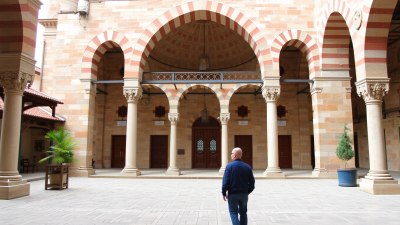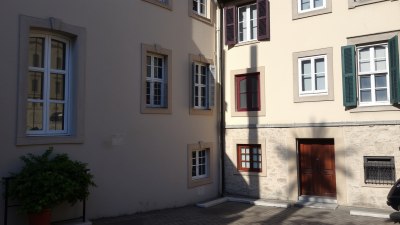Sarajevo's Historical Sites: Exploring Bosnia's Rich Past
Discover Sarajevo's rich history through its iconic historical sites and cultural heritage.

Image created with Flux Schnell
Sarajevo, the capital of Bosnia and Herzegovina, is a city steeped in history, where every corner tells a story of its rich past. From the Ottoman Empire to the Austro-Hungarian period, and through the tumult of the 20th century, Sarajevo's historical sites present a tapestry of cultural influences and epochal changes.
The Baščaršija District
The heart of Sarajevo's old town is the Baščaršija district, a well-preserved Ottoman marketplace filled with cobblestone streets, traditional craft shops, and historic mosques. At its center lies the Gazi Husrev-beg Mosque, built in 1531, which showcases stunning Islamic architecture and houses a significant library. Its courtyard is a serene escape often overlooked by the bustling market atmosphere.
Another significant historical site is the Latin Bridge, famous for its connection to an event that changed the world – the assassination of Archduke Franz Ferdinand in 1914. This event triggered a series of alliances and conflicts leading to World War I. The bridge itself is a beautiful, simple structure that spans the Miljacka River, surrounded by lush greenery and historical context.
The Vijećnica, or City Hall, is an architectural marvel that combines Moorish and Byzantine elements. Built in the late 19th century during the Austro-Hungarian rule, it served as the city hall until the onset of World War II. Today, it houses the National and University Library of Bosnia and Herzegovina, symbolizing the city’s resilience and cultural importance.
Honoring the victims of World War II, the Eternal Flame is a monument that burns continuously as a tribute to the fallen in Sarajevo. Situated at the center of the city, the monument is a poignant reminder of the struggles faced during the war, representing hope and remembrance for the city’s future.
A more recent memory is captured at the Siege of Sarajevo Memorial, dedicated to the nearly four-year siege of the city during the Bosnian War (1992-1996). The memorial features a series of stone walls etched with the names of those who lost their lives, serving as a powerful testament to the resilience and strength of the Sarajevo populace amidst adversity.
One of the most notable religious landmarks in Sarajevo is the Sacred Heart Cathedral, the largest cathedral in Bosnia and Herzegovina. Built in 1889, it showcases stunning neo-gothic architecture and serves as the center of the Catholic community. Visitors are often captivated by its magnificent stained glass windows and serene atmosphere, which offers a moment of reflection amidst the city's bustling life.
Cultural diversity is a hallmark of Sarajevo, evidenced by the Yellow Rule, which is epitomized in the city’s places of worship. Within a short distance, you can find the Catholic cathedral, the Gazi Husrev-beg Mosque, and a Serbian Orthodox church, reflecting the city's multi-faith heritage and the historical coexistence of different cultural groups.
A historical site that gained prominence during the Bosnian War is the Sarajevo Tunnel, also known as the Tunnel of Hope. This underground tunnel connected Sarajevo to the outside world during the siege, allowing for the transport of goods and people. Today, part of the tunnel is preserved as a museum, illustrating the stark reality of life during the siege and the ingenuity of those who survived it.
The Historical Museum showcases artifacts, exhibitions, and images that chronicle Bosnia and Herzegovina's past. Housed in a building that itself is a piece of history, the museum invites visitors to engage with a diverse collection ranging from prehistoric times to the contemporary era, highlighting the rich cultural tapestry of the region.
While not an architectural site, Vrelo Bosne is an important natural landmark located just outside of Sarajevo. It is the source of the river Bosna, surrounded by stunning nature and walking paths. Visitors can take a traditional horse-drawn carriage ride along the scenic paths and enjoy the tranquil beauty that has inspired many artists and writers through the centuries.
The Gazi Husrev-beg Museum is a must-visit for those interested in the cultural heritage of Sarajevo. Located adjacent to the Gazi Husrev-beg Mosque, the museum displays artifacts related to the Ottoman period, including textiles, manuscripts, and weapons, providing insight into the daily life of the city during that time.
Reflecting Sarajevo’s Jewish heritage, the Jewish Museum offers a glimpse into the life and contributions of the Jewish community in Bosnia and Herzegovina. The museum holds a collection of historical documents, photographs, and religious artifacts, emphasizing Jewish culture’s role within the broader narrative of Sarajevo’s history.
A more somber site is the Museum of Crimes Against Humanity and Genocide, which addresses the dark chapter of the country's history during the Bosnian War. The museum serves as an educational resource, helping visitors understand the complexities of the conflict and the path towards reconciliation and healing.
As the number of tourists visiting Sarajevo grows, efforts to preserve these historical sites have become increasingly important. Local and international organizations are working together to restore and maintain the architectural heritage, ensuring that future generations can appreciate the profound significance of these spaces. With guided tours and informational plaques, visitors can explore the city’s historical narratives and cultural significance in depth.
No exploration of Sarajevo would be complete without indulging in its gastronomic heritage. The city offers a variety of traditional dishes reflecting the cultural influences that have shaped it over centuries. Bosnian coffee, a strong and flavorful brew, is a must-try, preferably enjoyed in a traditional setting. Additionally, dishes like ćevapi (grilled minced meat), pita (savory pastry), and baklava (sweet dessert) offer delicious insights into the culinary traditions of the region.
Sarajevo’s historical sites form a rich tapestry of cultural heritage and resilience. From the Ottoman-era architecture to the memorials of modern conflict, each site speaks to the complex narrative of a city that has faced tremendous challenges yet continues to honor its past while looking towards the future. Those who journey through the streets of Sarajevo will find not just a city, but a living history that invites reflection and appreciation.











